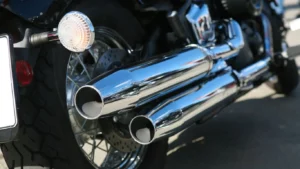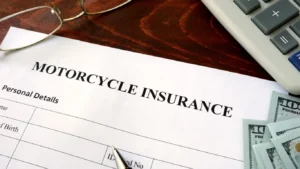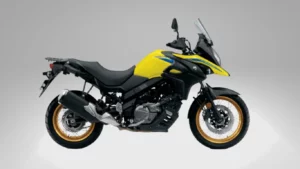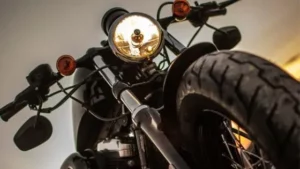t is possible to install LED lights on a motorcycle. In fact, many motorcycle enthusiasts install LED lights to improve their visibility on the road and enhance the style of their bikes. LED lights are energy-efficient, long-lasting, and available in a wide range of colors and styles.
However, it is important to follow the manufacturer’s instructions and use appropriate safety precautions while installing the LED lights. Additionally, some jurisdictions may have regulations on the use of LED lights on motorcycles, so be sure to check the local laws before installing them.
How Do You Run LED Lights on A Motorcycle?
Running LED lights on a motorcycle can be done in several ways, depending on the type of LED lights and the motorcycle’s electrical system.
Here are some steps to follow:
1. Choose the LED lights
The type of LED lights you choose for your motorcycle depends on your specific needs and preferences. Here are some common types of LED lights that are often used on motorcycles:
Accent lights:
These are small LED lights that are used to add extra illumination to your motorcycle. They can be mounted on various parts of the bike, such as the engine, wheels, or frame.
Running lights:
These are LED lights that are used to increase visibility while riding, especially during the day. They can be mounted on the front or rear of the motorcycle and are always on while the motorcycle is running.
Turn signals:
These are LED lights that replace the stock turn signals on your motorcycle. They are brighter and more visible than stock signals, increasing your visibility to other drivers.
Brake lights:
These are LED lights that replace the stock brake lights on your motorcycle. They are brighter and more visible than stock lights, increasing your visibility to other drivers.
Headlights:
LED headlights are brighter and more energy-efficient than traditional headlights. They can improve your visibility while riding at night or in low light conditions.
Consider your needs and budget when choosing LED lights for your motorcycle. You may also want to consult with a professional to ensure proper installation and compatibility with your motorcycle’s electrical system.
If you want to know how to install a headlight on a dirt bike without a battery, you can read our article in which I have provided step-by-step instructions.
2. Decide on the power source
When it comes to choosing a power source for your LED lights, there are a few options to consider:
The most common power source for LED lights on a motorcycle is the motorcycle battery. This option is relatively easy to install and doesn’t require any additional wiring or components.
You can also choose to install a separate battery to power your LED lights. This option is useful if you want to run a lot of LED lights or if you’re concerned about draining your motorcycle’s battery.
If you’re concerned about overloading your motorcycle’s electrical system, you can install a regulator/rectifier to regulate the voltage and protect your battery.
When choosing a power source for your LED lights, make sure to check the voltage requirements of the lights and ensure that the power source can provide enough power to run them.
You should also consider the additional load that the LED lights will place on your motorcycle’s electrical system, especially if you have other accessories installed.
If you’re unsure about which power source to choose or how to install it, consult with a professional or refer to the manufacturer’s instructions.
3. Install a fuse
Installing a fuse is an important safety measure when installing LED lights on your motorcycle. A fuse protects your motorcycle’s electrical system from damage in the event of a short circuit or other electrical problem. Here are the steps to install a fuse for your LED lights:
Consult the manufacturer’s instructions for your LED lights to determine the appropriate fuse size. The fuse size should be based on the maximum current draw of your LED lights.
Choose a fuse holder that matches the fuse size and is compatible with your LED lights. The fuse holder should be able to handle the maximum current draw of your LED lights.
Install the fuse holder in a secure and accessible location on your motorcycle. Make sure the holder is connected to the positive (red) wire of your LED lights.
Install the appropriate size fuse into the fuse holder. Make sure the fuse is securely in place and the holder is closed.
Turn on your motorcycle and test your LED lights to make sure they are working properly. If there are any issues, check the wiring and connections.
By installing a fuse for your LED lights, you are helping to protect your motorcycle’s electrical system and preventing potential damage or safety hazards.
4. Connect the LED lights
Connecting the LED lights to your motorcycle’s electrical system requires some basic wiring knowledge and skills. Here are the steps to connect your LED lights:
Plan out the wiring layout for your LED lights. Determine where the LED lights will be installed and where the wires will be routed.
Connect the positive (red) and negative (black) wires of your LED lights to the power source. If you’re using the motorcycle battery as the power source, connect the positive wire to the positive terminal of the battery and the negative wire to the negative terminal of the battery. If you’re using a separate battery, connect the positive wire to the positive terminal of the battery and the negative wire to the negative terminal of the battery.
Install a switch to turn your LED lights on and off. Connect the switch to the positive wire of your LED lights.
If you’re running a large number of LED lights or if your LED lights draw a lot of power, you may need to install a relay to handle the extra load. Connect the relay to the positive wire of your LED lights and the power source.
Secure the wires to your motorcycle using zip ties or other fasteners. Make sure the wires are routed away from any moving parts or hot surfaces.
Turn on your motorcycle and test your LED lights to make sure they are working properly. If there are any issues, check the wiring and connections.
By following these steps, you can connect your LED lights to your motorcycle’s electrical system and enjoy the added visibility and style that they provide.
5. Mount the LED lights
Mounting the LED lights on your motorcycle requires some basic tools and hardware.
Here are the steps to mount your LED lights:
Choose a location on your motorcycle where you want to mount your LED lights. Some common locations include the engine, wheels, frame, and under the seat.
Clean the mounting surface to remove any dirt, debris, or oil. Make sure the surface is dry and free of any contaminants.
Use the appropriate mounting hardware to install the LED lights. Depending on the location, you may need to use brackets, screws, bolts, or adhesive.
Connect the wiring of your LED lights to the power source, switch, and relay (if necessary). Make sure the connections are secure and properly insulated.
Route the wiring to your power source and switch. Make sure the wiring is securely fastened and protected from any sharp edges or moving parts.
Adjust the angle of the LED lights to direct the beam where you want it. Use the mounting hardware to secure the lights in place.
Turn on your motorcycle and test your LED lights to make sure they are working properly. If there are any issues, check the wiring and connections.
By following these steps, you can mount your LED lights on your motorcycle and enjoy the added visibility and style that they provide. Make sure to follow the manufacturer’s instructions and use appropriate safety precautions while installing the LED lights.
6. Test the LED lights
Testing the LED lights on your motorcycle is an important step to ensure that they are working properly and safely. Here are the steps to test your LED lights:
Make sure your motorcycle is turned on and running.
Turn on the switch for your LED lights. If you have a relay, make sure it is also turned on.
Check the brightness of your LED lights to make sure they are working properly. If the lights are dim or flickering, there may be a problem with the wiring or power source.
Check the direction of the LED lights’ beams to make sure they are pointed where you want them. Adjust the angle of the lights if necessary.
Look for any signs of overheating, smoking, or other issues with the LED lights or wiring. If there are any problems, turn off the lights and troubleshoot the issue before continuing to use the lights.
If you have installed LED turn signals, test them to make sure they are working properly. Turn on your motorcycle’s turn signals and check that the LED lights are flashing at the correct speed and brightness.
By following these steps, you can test your LED lights and make sure they are working properly and safely. If you notice any problems during the test, troubleshoot the issue and fix it before continuing to use the lights.
Do LED lights need batteries on a Motorcycle?
LED lights on a motorcycle can be powered by the motorcycle’s electrical system or a separate battery. If you choose to power the LED lights from the motorcycle’s electrical system, you will not need a separate battery. However, if you are running a large number of LED lights or if your LED lights draw a lot of power, it may be necessary to install a separate battery to handle the load.
In this case, the LED lights would be connected to the separate battery instead of the motorcycle’s electrical system. Regardless of the power source, it is important to use appropriate safety precautions and follow the manufacturer’s instructions while installing and using LED lights on a motorcycle.
Are LEDs illegal on Motorcycles?
In most jurisdictions, LED lights are not illegal on motorcycles. However, there may be restrictions on the color, brightness, and placement of LED lights on motorcycles. For example, in some areas, it may be illegal to have flashing or blinking LED lights on a motorcycle or to have LED lights that emit blue or red light. It is important to check the local laws and regulations before installing LED lights on a motorcycle.
Additionally, if the LED lights are too bright or are aimed in a way that could cause distraction or glare for other drivers, they may be considered unsafe and could result in a citation. So, while LED lights are generally legal on motorcycles, it is important to use them responsibly and within the guidelines set by your local laws.
Which Colors of Motorcycle LED Lights Are illegal?
The legality of LED light colors for motorcycles varies by jurisdiction. In general, most areas allow white and amber LED lights on motorcycles for use as headlights, turn signals, and running lights. However, the use of blue and red LED lights on motorcycles is usually restricted, as these colors are often associated with emergency vehicles.
In many places, blue and red LED lights are prohibited from use on motorcycles, except for certain authorized vehicles such as law enforcement or emergency vehicles. The use of these colors on motorcycles is often considered a violation of traffic laws and can result in fines or even impoundment of the vehicle. Some areas may allow the use of blue and red LED lights for decorative or cosmetic purposes only, but they may not be allowed to flash or blink.
It’s important to note that laws regarding LED light colors on motorcycles can vary by location and can change over time. Therefore, it’s always a good idea to check the local laws and regulations before installing any LED lights on your motorcycle.
Conclusion
LED lights are a popular and practical addition to motorcycles that can enhance both their style and visibility. Following the manufacturer’s instructions and taking the necessary safety precautions will enable you to install these. The electrical system of the motorcycle or an external battery can both power LED lights, depending on their size and power requirements.
It’s crucial to check local rules and regulations as some colors and uses may be limited, even though the majority of jurisdictions permit white and amber LED lights on motorcycles. LED lights can be a great way to customize your motorcycle and make it more visible on the road, but it’s important to use them safely and responsibly.






